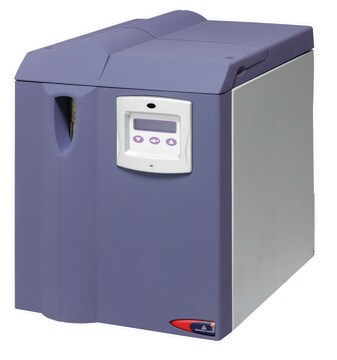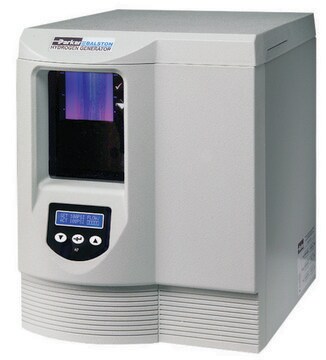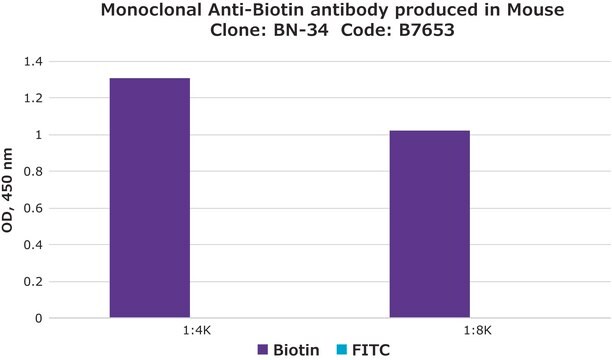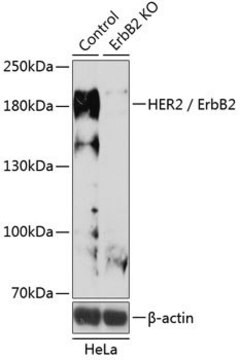30558
Abberior® STAR 635, NHS-Ester
for STED application
Synonym(e):
superauflösende Mikroskopie
Anmeldenzur Ansicht organisationsspezifischer und vertraglich vereinbarter Preise
Alle Fotos(1)
About This Item
UNSPSC-Code:
12352108
NACRES:
NA.32
Empfohlene Produkte
Konzentration
≥50.0% (degree of coupling)
Löslichkeit
DMF: 0.25 mg/mL, clear
Fluoreszenz
λex 635 nm; λem 655 nm±10 nm in PBS, pH 7.4
Lagertemp.
−20°C
Allgemeine Beschreibung
Maximale Absorption, λmax: 635 nm (PBS, pH 7,4)
Extinktionskoeffizient, ε(λmax): 110.000 M-1cm-1 (PBS, pH 7,4)
Berichtigungsfaktor, CF260 = ε260/εmax: 0,26 (PBS, pH 7,4)
Berichtigungsfaktor, CF280 = ε280/εmax: 0,38 (PBS, pH 7,4)
Maximale Fluoreszenz, λfl: 656 nm (aq. Acetonitril; MeOH)
655 nm (PBS, pH 7,4)
Empfohlene STED-Wellenlänge, λSTED: 750 −780 nm
Fluoreszenz-Quantenausbeute, η: 0,88 (PBS, pH 7,4)
Fluoreszenzlebensdauer, τ: 2,8 (PBS, pH 7,4)
Extinktionskoeffizient, ε(λmax): 110.000 M-1cm-1 (PBS, pH 7,4)
Berichtigungsfaktor, CF260 = ε260/εmax: 0,26 (PBS, pH 7,4)
Berichtigungsfaktor, CF280 = ε280/εmax: 0,38 (PBS, pH 7,4)
Maximale Fluoreszenz, λfl: 656 nm (aq. Acetonitril; MeOH)
655 nm (PBS, pH 7,4)
Empfohlene STED-Wellenlänge, λSTED: 750 −780 nm
Fluoreszenz-Quantenausbeute, η: 0,88 (PBS, pH 7,4)
Fluoreszenzlebensdauer, τ: 2,8 (PBS, pH 7,4)
Anwendung
- Der in der Ziege hergestellte Abberior™ STAR 635 Anti-Kaninchen-Antikörper wird für die STED(Stimulated Emission Depletion)-Bildgebung von primär kultivierten striatalen Neuronen von Ratten verwendet.
- Der in der Ziege hergestellte Abberior™ STAR 635 Anti-Kaninchen-Antikörper wird für die STED-Bildgebung von nicht sensorischen Stützzellen aus der Cochlea von Ratten und Mäusen eingesetzt.
- Abberior™ STAR 635, konjugiert mit einem sekundären Antikörper, wird für die STED-Bildgebung von Mikrotubuli in Zellen genutzt.
Eignung
Entwickelt und getestet für die superauflösende Fluoreszenzmikroskopie
Sonstige Hinweise
Rechtliche Hinweise
6538 is a trademark of American Type Culture Collection
abberior is a registered trademark of Abberior GmbH
Ähnliches Produkt
Produkt-Nr.
Beschreibung
Preisangaben
Lagerklassenschlüssel
11 - Combustible Solids
WGK
WGK 3
Flammpunkt (°F)
Not applicable
Flammpunkt (°C)
Not applicable
Analysenzertifikate (COA)
Suchen Sie nach Analysenzertifikate (COA), indem Sie die Lot-/Chargennummer des Produkts eingeben. Lot- und Chargennummern sind auf dem Produktetikett hinter den Wörtern ‘Lot’ oder ‘Batch’ (Lot oder Charge) zu finden.
Besitzen Sie dieses Produkt bereits?
In der Dokumentenbibliothek finden Sie die Dokumentation zu den Produkten, die Sie kürzlich erworben haben.
Hans Blom et al.
PloS one, 8(9), e75155-e75155 (2013-09-24)
The phosphoprotein DARPP-32 (dopamine and cyclic adenosine 3´, 5´-monophosphate-regulated phosphoprotein, 32 kDa) is an important component in the molecular regulation of postsynaptic signaling in neostriatum. Despite the importance of this phosphoprotein, there is as yet little known about the nanoscale
Jenu Varghese Chacko et al.
Journal of biomedical optics, 19(10), 105003-105003 (2014-10-08)
Atomic force microscopes (AFM) provide topographical and mechanical information of the sample with very good axial resolution, but are limited in terms of chemical specificity and operation time-scale. An optical microscope coupled to an AFM can recognize and target an
Arnaud P Giese et al.
Development (Cambridge, England), 139(20), 3775-3785 (2012-09-20)
Vangl2 is one of the central proteins controlling the establishment of planar cell polarity in multiple tissues of different species. Previous studies suggest that the localization of the Vangl2 protein to specific intracellular microdomains is crucial for its function. However
S W Hell et al.
Optics letters, 19(11), 780-782 (1994-06-01)
We propose a new type of scanning fluorescence microscope capable of resolving 35 nm in the far field. We overcome the diffraction resolution limit by employing stimulated emission to inhibit the fluorescence process in the outer regions of the excitation
Marcus Dyba et al.
Nature biotechnology, 21(11), 1303-1304 (2003-10-21)
We report immunofluorescence imaging with a spatial resolution well beyond the diffraction limit. An axial resolution of approximately 50 nm, corresponding to 1/16 of the irradiation wavelength of 793 nm, is achieved by stimulated emission depletion through opposing lenses. We
Unser Team von Wissenschaftlern verfügt über Erfahrung in allen Forschungsbereichen einschließlich Life Science, Materialwissenschaften, chemischer Synthese, Chromatographie, Analytik und vielen mehr..
Setzen Sie sich mit dem technischen Dienst in Verbindung.




